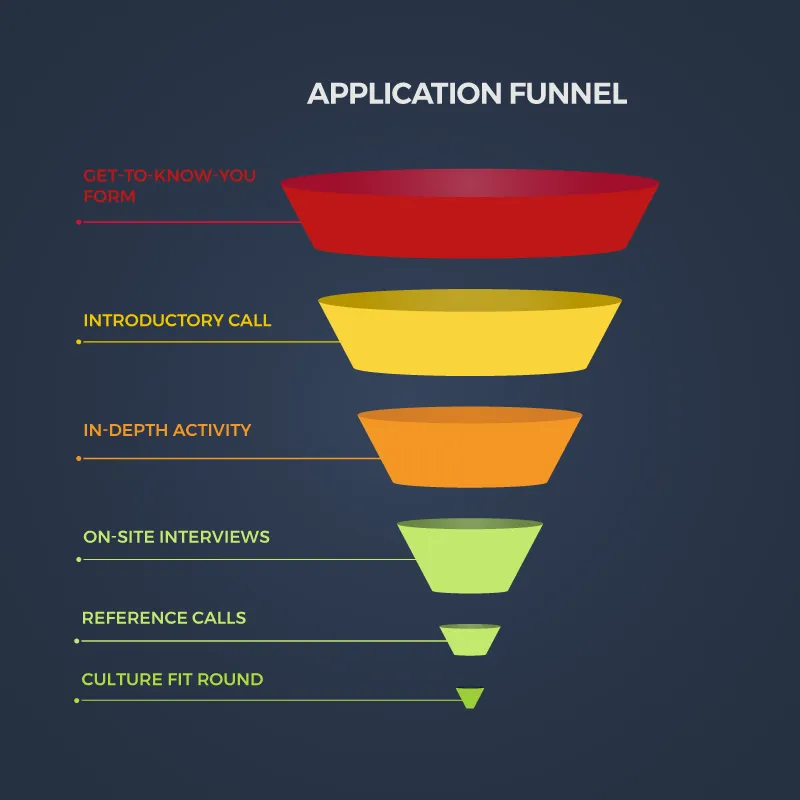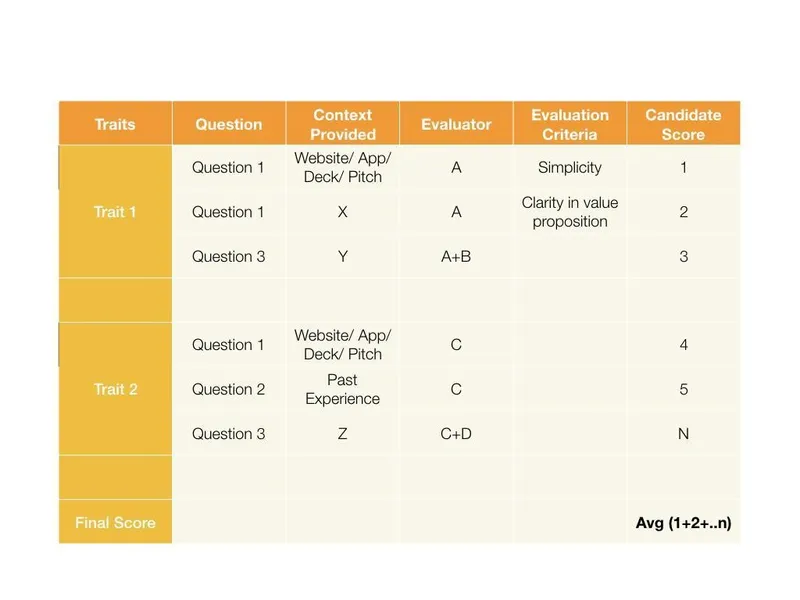Building your startup dream team: a step-by-step guide to hiring
As a growing organisation, a startup will do well to have a streamlined process in place for the hiring, interviewing, vetting and onboarding of candidates, with clearly defined steps to ensure process consistency among all internal decision makers.

In Part One of our hiring series, we shared how a sales-like approach to hiring can multiply one’s results. Owing to a strong outbound engine, coupled with optimised recruitment partnerships, and hiring channels, you can have a sufficient number of candidates at the top of the funnel. So, what next?
In this part-2, I’ll walk you through how you can ensure candidates move smoothly through the interview process and there is zero compromise on the quality of people that join your team.
As a founder, when your team is small, you are personally able to critically evaluate each candidate. But as the team grows, multiple stakeholders start getting involved and you are not the only one taking the decision. This calls for a streamlined process with clearly defined steps to ensure process consistency among all internal decision makers.
A) Create a job description
This one’s quite obvious, but it’s important how you go about executing it. Treat this as your sales pitch to the ideal candidate. You can even go really creative here and do something like this video by Salesforce. But whatever you do, the most important thing is to sell right.
Apart from the regular role responsibilities and requirements, start with describing what your company is building, why you are building it, and what’s it like to work with you. Include company videos/photos/blog posts and give strong reasons for why an experienced candidate should take you seriously.
Writing a job description is something that members of your team will do very often, and it will not always be the same person doing it. Productising repetitive aspects of this process can help remove any biases and also ensure that the process runs smoothly without any internal communication loss.
At Squad, for example, the hiring owner creates the first version of the job description using a predefined template. This helps ensure standardisation across all roles. Within the description:
- Define persona and key traitsWhat does this person’s profile look like? What’s her academic pedigree like? What type of professional experience does she hold? Which companies has she worked with?
- Define compensation bracket
- For new roles, which we haven’t hired for before, we conduct a detailed market analysis for ideal market compensation. For most of the roles a certain percentage of the market cut in cash is expected; we compensate that by offering ESOPs.ESOPs are a great way to inspire team members to think about long-term value creation and boosts morale. It also encourages the team to think about the company’s holistic success.
B) Define the hiring process
Each hiring consists of multiple stakeholders, involved at different steps of the process. One needs to make sure that everyone has clarity on their responsibilities in the process.
Just like the job description, the hiring owner can use a predefined template to share with internal stakeholders the whole process and steps involved in hiring for a particular role.
Any process document must include the following:
- The exact persona of the role (to help shortlist candidates)
- Interview stages
- Owner at each stage (ensures responsibility)
- Key traits required for the role and how to check for them at each stage
- The candidate’s career growth path in that role
- Personalised ‘introduction email’ (to be sent out to the candidates once they’ve applied)
C) Distribution
Once we’ve finished defining the overall process of hiring, the next step is figuring out distribution.
In broad strokes, think about all the online spots the ideal candidate would be hanging out at. Are they on any specific job portals, communities or groups? In case of freshers, any specific schools that specialise in the skills you are looking for?
Pro-tip: One key channel here is ‘referrals’. If your whole team hasn’t spent time asking friends and acquaintances to apply then you’re probably missing out on some great candidates.
We’ve shared detailed insights on acing distribution in Part One of this series.
D) The interview process
Though this varies from role to role, the basic structure remains more or less the same:

- A get-to-know-you form Kick off your interview process with a basic form where you ask the candidate a few questions related to the role they are applying for. This, coupled with their resume, acts as the first assessment filter.This also ensures that you aren’t wasting time assessing candidates who just applied because it’s as easy and fast as clicking a button.For technical roles, include a small activity to test programming capabilities.
- Introductory callConduct a short 30-45 minutes call to discuss the role responsibilities and get a brief background of the applicant. This is no less than a sales call because if you want the best talent to work with you, you must truthfully explain to them the impact that your business is making on its target market, the social change its bringing about, and how every day brings with it another set of interesting challenges and learning opportunities.A good pitch also helps ensuring that there are no drop-offs in later stages of the process, wherein the candidate is expected to invest more time and effort when completing assessment activities. (Read below.).
- ActivityFor selected candidates, the introductory call is followed up with an in-depth activity to test skills and requirements for the particular role. This requires anywhere between six and 20 hrs of time invested on their end.When designed correctly, you’ll be able to efficiently gauge the skills and capabilities of every candidate. This stage also brings about quite a number of drop-offs since the less interested candidates don’t follow through.However, if there are too many drop-offs here then there’s merit in considering that you might have not designed the activity well enough and need to get back to the drawing board. Additionally, regularly taking feedback from the candidates who are attempting the activity also helps in streamlining the process.
- In-person/video-call roundSplit this into two parts - a) Follow-up discussions on the activity and b) A final round where you deeply discuss the immediate responsibilities and shared expectations.
- This also provides the candidates an opportunity to interact with your team and really get a feel of how work happens at your startup.For engineering roles, have the candidates spend a full day at your office where they go through multiple rounds. This day-long exercise can also include a round where they have to assist a few members of your team in solving a real engineering problem (Some of this is heavily inspired from Stripe's onsite engineering process).In case the candidates are working remotely then all the above happens over Skype or Zoom conference calls.
- Culture roundA firm’s values is one of the key pillars that defines what it does.
- Every interview process should end with a culture fit round with one of the founders.
- Reference calls Reference check calls should be run in parallel with the above process.Make sure to talk to at least two people that the candidate has worked with previously, preferably a coworker and their ex-manager. While most reference calls don’t reveal concrete information (and people usually share only positive references), you can still find some useful titbits if you ask the right questions.
E) Evaluation
As humans, a majority of us make use of our ‘gut instinct’ while making the final call on a hiring decision, and more often than not it doesn’t turn out to be the right decision.
Result: churn, and not to mention all the hiring effort that immediately goes down the drain.
Which is why it is wise to use data internally to make hiring decisions. This ensures you are removing any biases and doing a holistic evaluation before coming to a conclusion.
(Related read - Develop your hiring system like a product to eliminate bias and boost retention)
Having a well-defined scoring matrix that scores everything from the traits you are looking for, to values, skills, strengths and weaknesses helps in making more informed decisions.

Taking inspiration from hiring committees at Google for the final leg of your evaluation for an engineering hire, hold a debriefing where all the stakeholders involved in the hiring process submit their evaluations. These should then be collated, discussed and debated upon before making a final hiring decision on the candidate.
F) Making the offer
And then we’re finally here – we’ve found our knight in shining armour to spearhead critical business processes.
But we still have to do some not-so-interesting stuff, like sending out an offer letter, getting legal papers signed, and more. Back and forth communication with different members on the team just to send simple document with a few details is something I’m sure none of us fancy.
The solution here, is simple. Productise this process to ensure there are no loose ends:
- The hiring owner fills out a form that captures all basic but essential information like - name, offered designations, compensation etc.
- Your admin team receives the form and then coordinates with the candidate by sending a post-interview introductory email (using a predefined template).
- In this post-interview introductory email, admin requests for additional legal information and documentation proof from the candidate.
- Once received and vetted, the admin sends the offer letter and an NDA to the candidate
After the candidate sends back signed copies of these documents, you kick-start the onboarding process, which I’ll talk about more in Part-3 of this series.
(Disclaimer: The views and opinions expressed in this article are those of the author and do not necessarily reflect the views of YourStory.)







